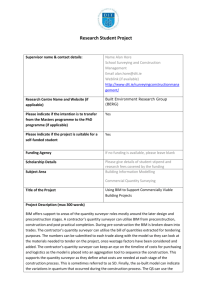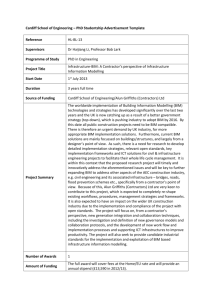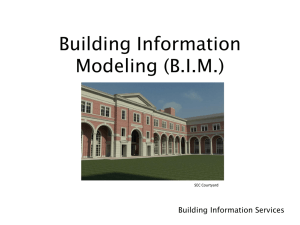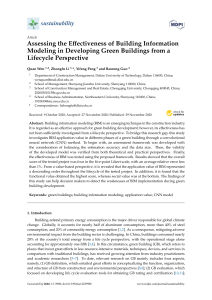1 The concern about the climate change and resource depletion issue... increasing around the world. Building and construction sector has been...
advertisement
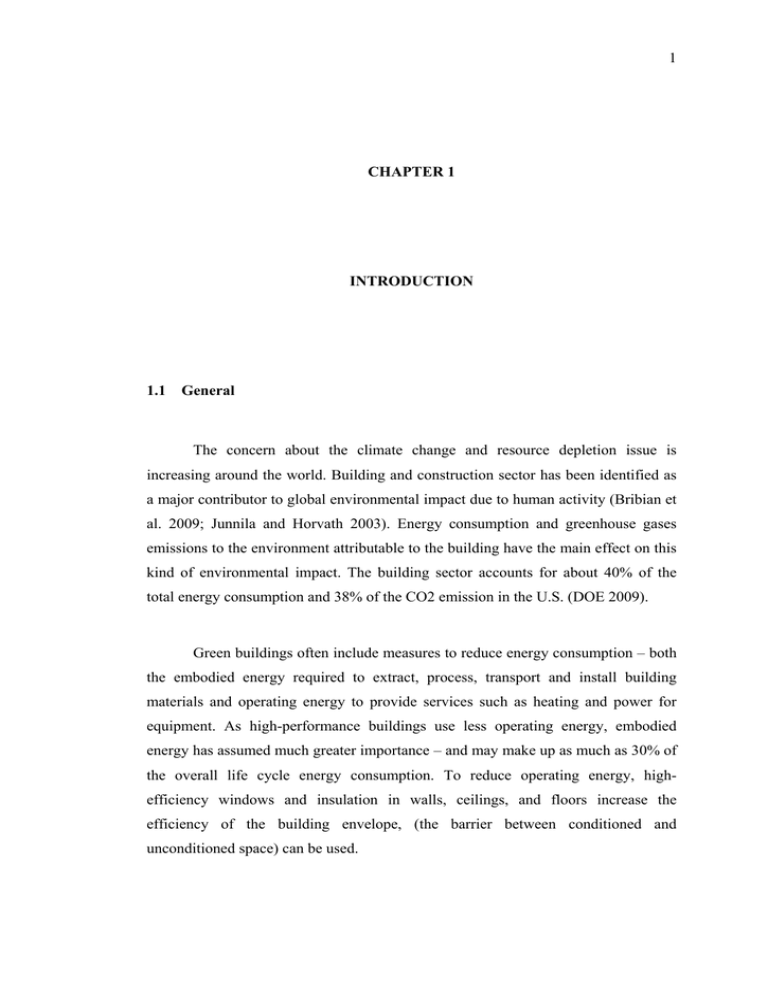
1 CHAPTER 1 INTRODUCTION 1.1 General The concern about the climate change and resource depletion issue is increasing around the world. Building and construction sector has been identified as a major contributor to global environmental impact due to human activity (Bribian et al. 2009; Junnila and Horvath 2003). Energy consumption and greenhouse gases emissions to the environment attributable to the building have the main effect on this kind of environmental impact. The building sector accounts for about 40% of the total energy consumption and 38% of the CO2 emission in the U.S. (DOE 2009). Green buildings often include measures to reduce energy consumption – both the embodied energy required to extract, process, transport and install building materials and operating energy to provide services such as heating and power for equipment. As high-performance buildings use less operating energy, embodied energy has assumed much greater importance – and may make up as much as 30% of the overall life cycle energy consumption. To reduce operating energy, highefficiency windows and insulation in walls, ceilings, and floors increase the efficiency of the building envelope, (the barrier between conditioned and unconditioned space) can be used. 2 Nowadays, the BIM model is considered as an effective platform to overcome the difficulties of acquiring the necessary building data in LCA, and so it can provide great possibility for implementing whole building LCA in the design stage. Since, the opportunities for reducing the environmental impacts of the building LCA are limited after construction stage, the most effective decisions regarding to reducing the environmental impacts of the building are made in the preliminary (design) and preconstruction stages. One of the relevant issues today is implementing the traditional planning environment which energy and performance analysis of the buildings are typically performed after the architectural design and construction documents have been produced. This lack of integration into the design process causes an inefficient process of design modification to achieve a set of performance criteria which leads to wasting time and cost (Schueter and Thessling, 2008). Therefore for assessing the life cycle building performance in the early design stage, access to a comprehensive set of knowledge concerning on a building’s modules, materials and technical systems are required. Since Building Information Model (BIM) takes multidisciplinary information into an account, it creates an opportunity for life cycle assessment of building performance to be carried out throughout the design process (Scheuter and Thessling, 2008). 1.2 Problem Statement At present, concerning about the climate change and resource depletion issue is increasing around the world. Human activity has been considered as a main factor in construction industry contributed in global environmental impact (Bribián et al. 2009; Junnila and Horvath 2003). Energy consumption and greenhouse gases emissions to the environment attributable to the building have the fundamental role as the global environmental impact. The building sector accounts for about 40% of the total energy consumption and 38% of the CO2 emission in the U.S. (DOE 2009). 3 One of the relevant issues today is implementing the traditional planning environment which energy and performance analysis of the buildings are typically performed after architectural design and construction documents have been produced. The most effective decisions related with sustainable design of a building facility are made in the preconstruction and/or construction stages. This lack of integration into the design process leads to an inefficient process of retroactively modifying the design to achieve a set of performance criteria which leads to wasting extra time and cost. (Schueter and Thessling, 2008). Energy consumption analysis of buildings is a difficult task because it requires considering detailed interactions among the building, HVAC system, and surroundings (weather) as well as obtaining mathematical/physical models that are effective in characterizing each of those items. The dynamic behavior of the weather conditions and building operation, and the presence of multiple variables, requires the use of computer aid in the design and operation of high energy performance buildings. So the need to adopt a practical model solution is essential for doing the assessment of the whole building performance in the early design. Therefore for assessing the energy consumption of the building, access to a comprehensive set of knowledge concerning on a building’s modules, materials and technical systems are required. Since Building Information Model (BIM) takes multidisciplinary information into an account, it creates an opportunity for building performance assessment to be carried out throughout the design process (Scheuter and Thessling, 2008). 4 1.3 Aim and Objectives The aim of this study is to evaluate the potential of utilizing BIM to carry out the assessment of performance of the building in terms of energy consumption. In order to achieve the aim, the objectives of the study are as follows: 1. To gather necessary information such as drawing plan, materials specification and etc for simulation 2. To simulate the whole building by using BIM tool 3. To assess the existing annual energy consumption of the building 4. To evaluate building performance in term of energy consumption for alternative specifications 1.4 Scope of Study Scope of the study covers the annual operational life cycle energy consumption of the building. A double storey building located in Taman Universiti, Skudai was simulated through BIM tools. Since Malaysia is considered as a tropical country, there is no heating load but only just cooling load was considered in the calculation of annual energy consumption. 1.5 Significance of Study Building simulation and investigating the performance of the building virtually in the preconstruction and/or even during construction stage will help decision makers, designers, engineer, and architects to select specifications with the 5 least impact to the environment. In building construction sector, BIM can be beneficial for the building designers to determine the best building orientation and designs. At the design and preconstruction stages, Building Information Model (BIM) as a comprehensive simulation method can be taken into an account to create an opportunity in assessing of building performances for the purpose of improving them. This integration of BIM concept into the design stage can reduce the design modification process for achieving a set of performance which leads to avoid spending of extra time and cost and select the best green building design. So this integration for the environmental impact prevention and minimizing the energy costs are beginning to reveal beneficial effects in terms of more efficient building design, improved building performance and minimization of the environmental risks.




